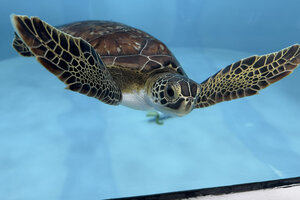Hurricane Milton: Even a sea turtle is part of Tampa’s evacuation from storm

With Hurricane Milton moving toward the Tampa Bay region, sea turtle biologists and veterinarians scrambled to move this sea turtle, Calintina, to safety. The turtle was washed ashore during Hurricane Helene.
Courtesy of The Florida Aquarium
With Hurricane Milton churning across the unusually warm waters of the Gulf of Mexico – and aimed directly at the west coast of Florida – hundreds of thousands of Floridians are leaving their homes, following mandatory evacuation orders. State officials are scrambling to remove debris left from Hurricane Helene, while search and rescue teams have arrived, ready to help with what they fear could soon be a disaster zone.
Meanwhile, in the town of Apollo Beach, scientists and veterinarians have been scrambling to save a single sea turtle already displaced once by extreme weather, and now at risk again. They have also been working to evacuate thousands of coral.
These may seem like small endeavors compared with larger storm preparations that are primarily about human safety. But they are reminders both of the wide-ranging activities threatened by the storm – as well as the compassion that people are showing in the face of it.
Why We Wrote This
As Hurricane Milton barrels toward Florida, the first priority is on readying humans for its impact. Amid the preparations, scientists are also tending to animals in their care.
“The threat we humans in Florida are currently facing with a looming hurricane is similar to the ongoing threats many marine animals face in their environment on a daily basis,” says Debborah Luke, senior vice president of conservation at The Florida Aquarium in a text message. “Humans are a part of nature, not apart from it, and the compassion we provide to the animals in our care is no different than what we strive to provide for our friends and community. We are all connected, and by working together, we can make an ocean of difference.”
Residents spotted the turtle, which has been named Calintina, after it had been washed ashore during a storm surge caused by Hurricane Helene – a storm that was responsible for at least 227 deaths throughout the southeastern United States, and which damaged neighborhoods along the Gulf Coast near St. Petersburg.
A handful of local aquariums and nonprofit organizations are permitted by the U.S. Fish and Wildlife Service to rescue and rehabilitate these endangered marine reptiles. In this case, sea turtle biologists and veterinarians from the Clearwater Marine Aquarium’s rescue and rehab team helped retrieve the turtle and then worked with colleagues from The Florida Aquarium to transfer it to its Sea Turtle Rehabilitation Center in Apollo Beach.
But it soon became clear that the juvenile turtle would need to move again. The Apollo Beach center, with its open walls and multiple rehabilitation pools, is not hardened to withstand a storm the likes of Milton.
“I think it’s been quite a wild ride for this turtle,” says Lindsey Waxman, staff veterinarian at The Florida Aquarium. “Starting out in the wild, riding through a hurricane, stranding in a ditch, and then getting rescued by Clearwater Marine Aquarium … and then to come here just in time to start rehab, start diagnostics and treatment, and then just get packed up again.”
The staff biologists moved the turtle to the Tampa campus of The Florida Aquarium. Although also in the predicted line of the hurricane, that facility has more protection, as well as engineers and veterinarians who will be riding out the storm with the animals.
As the warnings for Milton increased, a team of scientists also worked to move more than 4,000 coral juveniles from the Apollo Beach facility to partners on Florida’s east coast and in Georgia.
“These corals, including some rescued from last summer’s marine heatwave in the Florida Keys, are part of a broader initiative to safeguard species crucial to marine biodiversity,” The Florida Aquarium said in a press release, noting it’s the “only facility in the world to care for endangered pillar coral and holds the largest number of reproductive size elkhorn coral, and numerous colonies of both species are being evacuated.”
Earlier today, Calintina arrived safe and sound to the secure second floor of The Florida Aquarium’s Tampa campus.
Meteorologists predicted the storm to make landfall late Wednesday night. The National Hurricane Center is warning of up to 15 feet of storm surge.
Read more on Hurricane Milton: Why is Tampa so vulnerable to a large hurricane? While Floridians are no strangers to storms, Tampa hasn’t been in the direct path of a major hurricane in over a century. It has a huge population now facing an evacuation order.

